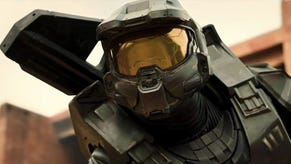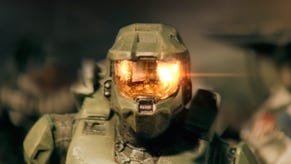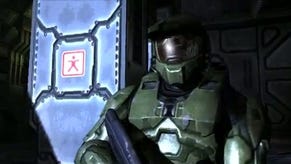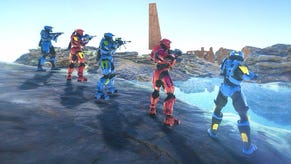Halo 2 Single Player Review
Can Microsoft's hype bomb blow everyone's expectations out of the water?
Expectation is such a double edged sword. The cultural obsession with building things up disproportionately (while simultaneously taking our eye off the ball elsewhere) seems to snowball with every passing year - and yet almost every single time a movie/album/game lets us down we still get suckered into the same cycle of buying into the frenzied hype. Then, if things haven't quite worked out, there's this psychological crash as people pick over what went wrong; people divide up into camps - the 'defend it to the hilt' faithful, the 'slag it off anyway' cynics, and the massive silent majority that go and buy it anyway, regardless of what anyone says. Halo 2 fits perfectly into this model.
Regardless of what we or anyone else thinks about Bungie's long-awaited sequel, Microsoft's job is already done. The millions of pre-orders are proof of that, not to mention those that would happily spend hundreds of dollars on eBay just to play it a few days early. Whatever. Some people will think it's the best thing ever, the 'too cool for school' crowd will scowl about it being 'just another shooter' in a determined effort to pretend they don't care, while millions rush out there and part with their cash regardless. But aside from all this, the expectations are simply too high. It can't ever be as good as anyone wants it to be. It just can't.
Let's try and defuse the hype bomb for a moment and bring some sanity to the whole ludicrous Halo 2 expectations and simply talk about it as if it was just A.N Other game and stop pretending its launch is in some way akin to the second coming of Christ. As far as the offline, story-based Campaign mode is concerned (as we're not reviewing the multiplayer until later this week) it's a bombastic first person sci-fi shooter not hugely different to the original. Visually more impressive, a few more impressive set pieces than before, slightly less boring repetitive parts (although, yes, they're still there), a few minor gameplay tweaks (which we'll go into in a moment), quite easy most of the time (on Normal), a more expansive storyline but overall not something that will have you leaping out of your chair screaming as if you've just seen the very future of entertainment. In calm, logical, rational hindsight, it's a high quality game that feels like a refinement of the original; a crafted, well-thought out evolution of the series that will satisfy the millions of fans around the world that they've got their money's worth. What it won't do, however, is do anything to convince the doubters that anything significant has happened over the intervening three years to make them any more interested in the Campaign side of the game than they were before. In short, if you liked it then, you'll lap this up - but if the original left you cold, so will this. The same old arguments that have been trawled out over the last three years as to why people did or didn't 'get' Halo are about to be revived, so get ready to don those flame retardant suits once more. Things are going to get heavy over the coming weeks.
Halo, boys
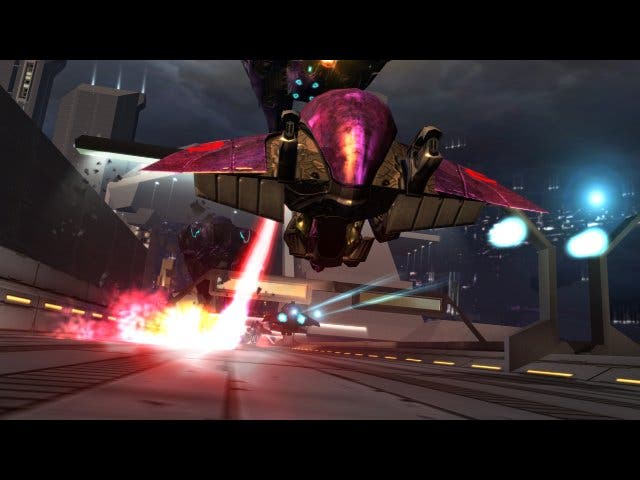
So. Anyway. Halo 2. It's 15 missions of epic sci-fi combat. A game that is, once again, "30 seconds of fun over and over" and a "game about guns where you don't have to think". And this isn't us cussing your favourite game - this is exactly what Bungie makes of the Halo series. So if you don't agree, don't shoot us. As we've touched upon already, one of the first things you'll notice about Halo 2 is that much more effort has been put into the story side of the game, with around some truly lavish and hugely impressive cut scenes regularly interspersing the action to deliver one of the most rounded Sci-fi tales ever to feature in a videogame. If there's one identifiable area where Bungie have really ramped up Halo 2 over the original it's here. The story comes at you in a surprising manner - and we wouldn't dare spoil it for you - but once the penny starts to drop as to how the game is going to progress it's one of those moments you'll always remember. For the big fans of the game it's like a dream come true right there and then - and one of those things you can't believe didn't leak out. No wonder Bungie didn't want any of the single player stuff to leak out.
But even when the game's not breaking off into another cut scene extravaganza, the sheer variety in the AI dialogue is consistently surprising, adding another layer to what might otherwise just descend into a straightforward 'clear the room and move onto the next wave' gameplay that Halo is so evidently built around. Whereas before the AI would endlessly repeat their stock phrases, even as you approach the end of the game you're still surprised by their incidental chat. It fills in the gaps, and adds another layer of suspension of disbelief, which is arguably Halo 2's greatest achievement.
While it's easy to knock Halo and its successor for adding up to a series of clear the area and move on' linear encounters until you reach the end of the game, so much of the enjoyment of Halo 2 is the lavish environments, so full of life, colour, detail and technical achievement that you actually don't really care too much about the inherent repetition of the gameplay. Just taking a look around at some of the breathtaking architecture, and the epic battles ongoing within them, you'd have to have a heart of stone not to be slightly impressed by that. Outside our window right now fireworks explode all around us; you could just wearily sigh about the noise, or you could just appreciate the aesthetic beauty in the carnival of colour in the sky. It's one of those situations to ponder on. If you like your games to look the part, then Halo 2 most definitely looks the part. The better the kit you have, then the better the game will look and sound; widescreen support is a huge plus, but throw in progressive scan support and probably the most well-conceived surround sound we've ever heard, an impressively dramatic score and characteristically over the top voices and the cinematic effect is complete.
Xbox evolved

Bungie wanted the game to be as much like a movie as possible, and with this technology it's fair to say that this is as far as a game has gone to achieve this goal with mind bogglingly lavish animation, and incredibly detailed characters set to a simply breathtaking set of backdrops. It's a feast for the eyes that's almost too much to take in in the space of a few days. We'll have to play through several times before we'll come close to appreciating the incredible effort and talent that has gone into this game. Next to most games we have the pleasure of playing through, Halo 2 goes further in trying to put the player in that environment; just sit back and listen to what's going on. Stop and simply watch the battles ensuing without any of your input at all. Take a close up view of a downed corpse. It's an assault on the senses. Is it as good a movie though? No. Of course, every developer will start out with that notion, but the limitations are there to see, still. The cracks show through once you play it for long enough, but no-one should have ever expected a PIII 733mhz-based machine with 64MB RAM and GeForce 3 graphics to do any more than this. If anything, it's the biggest two fingers to lazy PC development we've ever seen, and proof that if you optimise things enough there should be no reason why PC gamers should have to upgrade as much as they do, but that's another issue entirely. What is does show is the huge gulf between the Xbox and the PS2 when a decent developer is set to work on it with a gigantic budget from the world's richest software company.
So, okay, it's an audio visual feast, the likes of which console gaming has never seen. That'll be enough to sell it to most people; but what about those who aren't so easily impressed with normal mapping and don't get quite so dizzy with particle and real time lighting effects? The game, stood in cold isolation without all its fancy glad rags on hasn't really changed a great deal at all. With 15 chapters (and one of those merely an introduction) to run, gun and fly through, half of these are stand-out exciting sci-fi movie moments, packed with often incredible set pieces, and the other half are padding, full of the kind of pre-fabricated levels that the detractors of Halo bitched so heartily about.
After an extraordinarily dull introduction that seems unbelievably bad next to what follows, the game suddenly turns up the heat to such an extent you'd swear you could smell cordite as the innards of your console spontaneously frazzle with excitement. For sure, these moments will live long in the hearts of any gamer with a pulse, but then midway through the game we get the trademark Halo lull where Bungie appears to have bloody-mindedly ignored the fact that presenting the player with identikit repetitive sections in corridors, with similar encounters with the same bunch of enemies doesn't make for an especially entertaining and inspiring playing experience. It gets tiring, and at worst monotonous. Things once again improve to supernova proportions, but you're left wondering why Bungie couldn't have trimmed the fat and simply came up with a game that never stops wowing you. Why the need to pad things out with areas that are neither impressive to look at, or even that entertaining to play in? We don't get it.
No medals conferred
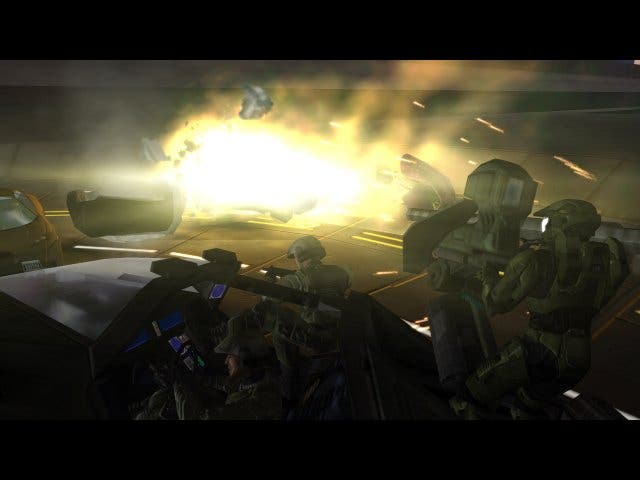
More baffling is why the game allows the player to run away. A few levels near the end were giving us a certain amount of hassle, so instead of getting bogged down in trying to see off enemies conscientiously, we simply legged it. The game let us, the enemy didn't bother following, we moved on, often able to bypass entire chunks with a little ingenuity. Why not force the player to face the repercussions by having a huge army chasing you in hot pursuit and nailing you in style? Instead you get to cheat by being a coward, and in turn exposing a major AI flaw where enemies are only allowed to patrol certain 'zones', so that once you're outside of that zone you're safe either way.
The same principle of cheating the game applies to when you enter a new zone - and this was inherent in the original as far as we recall. Faced with a barrage of new enemies, rather than use their intelligence and chase you down, they sit right where they are, always allowing you to track back and regain your health. It may well be part of the design, and certainly allows you to take a welcome breather, but as far as being combat evolved? Hardly. These two example of obvious exploits make the game feel very much still like a game, and not the involved, combat experience it often becomes when it's not letting the player get away with it. In the more convincingly designed areas where killing everything is the only way to move on, the game becomes an incredibly breathless experience where the AI starts to shine (especially on Legendary - Normal is if anything even more forgiving than it was in the original). AI grunts hunt you down, lobs grenades with terrifying accuracy, man emplacements, and run rings around you at times. It's not hugely different to the original, but it's still a cut above anything we've played in this genre, without hesitation. Later on in the game when the game dares to really pile on the headcount and aids you with powerful buddies, it feels like war. The day when they can increase the environment sizes and on screen enemies will be one to look forward to, but for now even the close combat set pieces are excellent fun, no matter how many times you have to go through them. That, for Halo fans, is at the heart of the enjoyment. That ability to approach a bunch of enemies and never have the same fight twice. Our advice, though, is ignore Normal difficulty. It's way too easy, and you'll breeze through the entire game virtually untroubled right the way to the end.
As for the changes and tweaks, there aren't actually that many to report. Sure, a few new weapons appear, you've got dual wielding, there are a few new enemies, the ability to hijack enemy craft and so on, but they're not massively significant, gameplay changing additions - certainly as far as Campaign mode in concerned. In terms of firepower, the majority are staples from the original, or slightly tweaked versions of. On the Covenant side the Plasma Pistol is as useless and ubiquitous as ever, the Plasma Rifle is the same as before (i.e., not very powerful, but does receive an upgraded version later), the Needler is marginally better (but not much), the Covenant Carbine is new but fairly lightweight in firepower and hamstrung by its single shot fire, the Particle Beam is another new addition and a very powerful at long range magnification, but sod all use in close quarters combat. Elsewhere, the Brute Shot grenade launcher makes a belated appearance - by which time its usefulness is somewhat negated thanks to limited ammo, while the excellent melee weapon, the Covenant Energy Sword is a superb means of despatching enemies at close quarters, while the Fuel Rod Gun acts like a concentrated flame thrower, pulsing out a beam of deadly energy, but not available for long.
Double trouble
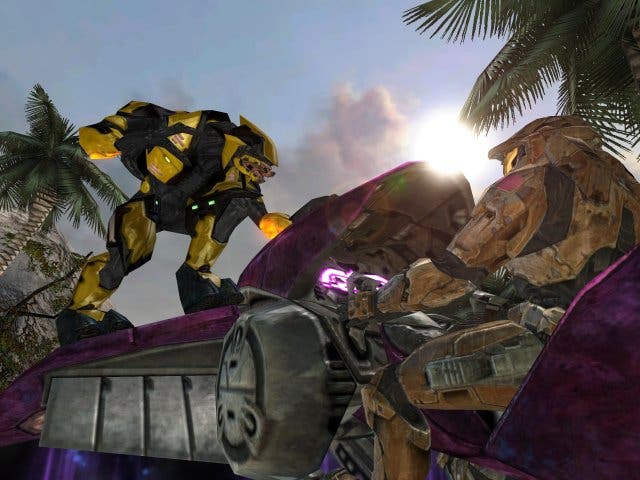
On the human's side, the Pistol and Rifle are pretty much your last resorts, the SMG is the Needler equivalent (i.e. of medium strength, but not what's really required against anyone but the smallest of enemy), the Sniper Rifle is useful but rarely seen, ditto the Rocket Launcher, while the Shotgun is great close up while it lasts. While most of the weapons we've just listed probably sound a bit crap in the main, used in dual wielding mode your firepower is suddenly doubled and you get to mix and match most of the lower powered weapons, thus turning you into a gun toting freak of some prowess (using both triggers, in case you were wondering). On the other hand, having two Needlers or Plasma Rifles negates your ability to whip out a Plasma or Frag Grenade and toast clusters of pursuing enemy. It's a fine balance, and although sounds like a very cool new addition soon becomes part of the furniture - the likelihood is that Dual Wielding will become more of an important issue in multiplayer, something we've yet to find out either way at the time of writing.
What's undoubtedly more impressive than a bunch of new weapons are the many more new vehicles you can drive or fly around in. The new improved Ghost and Banshee return, but only new and improved in terms of their looks and level of destructibility - they still handle much the same - while these small flying craft are joined by the ground craft. On the Covenant side there's the Wraith, Spectre and the awesome Shadow while the humans get two versions of the Warthog; one with a machine gun, one with a Gauss Cannon, while the piece de resistance is the incredible Scorpion tank - surely one of videogaming's most incredible pieces of destructive machinery yet.
Flying plays a relatively small part in the game this time, and fun though it most definitely is, it can't really hold a candle to the feeling of power that comes with driving either the Shadow or Scorpion. It's like being the boss monster for a change, and the first time you strap up in one of these bad boys is likely to have you grinning ear to ear as you wreak havoc with anything thrown at you. It really is one of those 'bring it on' moments, and exactly the sort of thing Halo players will have been desperate for. Almost as much fun is hijacking enemy vehicles, and surprisingly it's not actually that hard, requiring players to stab X when near enough, then mash the melee attack with B, before either popping a grenade down the hatch or legging it - again, this isn't especially important in single player (although definitely useful), but it's something we can imagine will be a huge part of multiplayer. All top notch additions, without a doubt, and all aided considerably by the levels of destructibility and physics that Bungie has heaped upon the game, not to mention the excellent particle effects as your equipment starts to smoke and spark, and the raw, crunchy sound effects that accompany them. It's hard to think how this could have been made any better - apart from maybe the ability to fight back from melee attacks (as, yes, even in single player it happens to you, and you do feel a little helpless while it's going on).
Better than Halo?
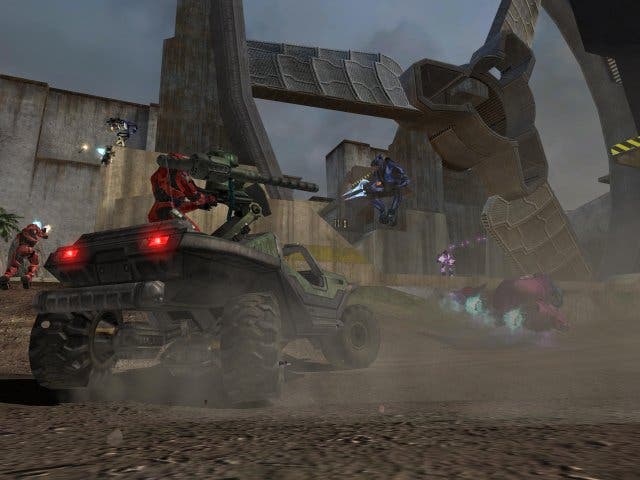
If you haven't already guessed from what you've read so far, the ante has most definitely been upped in Halo 2's Campaign mode, and while Microsoft is desperately hoping that the game will be a Live Trojan Horse (and only time will tell if this will really be the case), it's heartening to find out that the game is worth buying even if you have absolutely no intention of bothering with the game's multitude of online multiplayer options. Statistically, the overwhelming majority of people who buy Halo 2 won't care one iota for multiplayer (whatever the very vocal minority want you to believe), save for maybe the split screen co-op - so thank goodness Bungie hasn't really sacrificed the single player mode to make it into some sort of side show to the main event. It's very clear, having played through all 15 chapters (12 hours on Normal is probably a fair guess) that it's a much more consistent, more exciting game than the original with far less of the moody tedium that blighted the middle section of the original. As we said loud and clear, though, no-one should purchase Halo 2 with expectations that it's going to change their life or anything. The game has some welcome new additions, but in the main it sticks very rigidly to the formula that made the first game such a runaway success - it wasn't particularly broken, and should come as no surprise to find out that they didn't really do a huge amount to change it. And as far as the narrative side of the game goes for all its big budget grandiosity and Star Wars Episode Two brow furrowing leanings, it's still fairly throwaway stuff that most of us will take or leave. It's impressive, don't get us wrong, but it's the side dish to the main course - and that, as far as we're concerned is a good thing. We didn't want Metal Gear Solid levels of impenetrability anyway, thanks.
"But is it a ten?!" you're all busy screaming, while some of you are probably wryly still holding that score against us all this time. The truth is, the real Halo fans will say it's a ten, the unbelievers will nod reluctantly and cling onto their stubborn belief that it's not as good as everyone makes out it is and mentally score it an eight whatever, but we're going to sit on the fence for this one with a solid, creditable nine. The production values and the technical achievements of this game are almost beyond what anyone's managed in the short history of gaming, but that doesn't necessarily make up for the shortfalls. The truth is, for every hour our blood was pumping like a turbo charged locomotive through our adrenaline scored veins, there were an equal number of hours where we were bored with the unimaginative repetition of formulaic corridor based FPS trawls. On balance, we feel, the Campaign mode deserves a score somewhere that snugly sits between the two; it's an up and down game, and although it hits stellar heights, it trawls some murky depths, and for that we're not going to sit back and praise it unconditionally like some people might. But like we said all along, you probably made your mind up whether to buy it or not before we uttered a single word. The final word? Brilliant, but not enough of a progression to deserve top marks. Better than Halo? Yes.
Update: You can now read our take on the multiplayer side of the game here.


